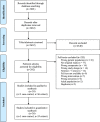Ancillary investigations for death determination in infants and children: a systematic review and meta-analysis
- PMID: 37131035
- PMCID: PMC10203011
- DOI: 10.1007/s12630-023-02418-1
Ancillary investigations for death determination in infants and children: a systematic review and meta-analysis
Abstract
Purpose: We performed a systematic review and meta-analysis to determine the diagnostic test accuracy of ancillary investigations for declaration of death by neurologic criteria (DNC) in infants and children.
Source: We searched MEDLINE, EMBASE, Web of Science, and Cochrane databases from their inception to June 2021 for relevant randomized controlled trials, observational studies, and abstracts published in the last three years. We identified relevant studies using Preferred Reporting Items for Systematic Reviews and Meta-Analysis methodology and a two-stage review. We assessed the risk of bias using the QUADAS-2 tool, and applied Grading of Recommendations Assessment, Development, and Evaluation methodology to determine the certainty of evidence. A fixed-effects model was used to meta-analyze pooled sensitivity and specificity data for each ancillary investigation with at least two studies.
Principal findings: Thirty-nine eligible manuscripts assessing 18 unique ancillary investigations (n = 866) were identified. The sensitivity and specificity ranged from 0.00 to 1.00 and 0.50 to 1.00, respectively. The quality of evidence was low to very low for all ancillary investigations, with the exception of radionuclide dynamic flow studies for which it was graded as moderate. Radionuclide scintigraphy using the lipophilic radiopharmaceutical 99mTc-hexamethylpropyleneamine oxime (HMPAO) with or without tomographic imaging were the most accurate ancillary investigations with a combined sensitivity of 0.99 (95% highest density interval [HDI], 0.89 to 1.00) and specificity of 0.97 (95% HDI, 0.65 to 1.00).
Conclusion: The ancillary investigation for DNC in infants and children with the greatest accuracy appears to be radionuclide scintigraphy using HMPAO with or without tomographic imaging; however, the certainty of the evidence is low. Nonimaging modalities performed at the bedside require further investigation.
Study registration: PROSPERO (CRD42021278788); registered 16 October 2021.
RéSUMé: OBJECTIF: Nous avons réalisé une revue systématique et une méta-analyse pour déterminer la précision des tests diagnostiques des examens auxiliaires pour la déclaration du décès selon des critères neurologiques (DCN) chez les nourrissons et les enfants.
Sources: Nous avons effectué des recherches dans les bases de données MEDLINE, EMBASE, Web of Science et Cochrane de leur création jusqu’en juin 2021 pour trouver des études randomisées contrôlées, des études observationnelles et des résumés pertinents publiés au cours des trois dernières années. Nous avons identifié les études pertinentes utilisant la méthodologie PRISMA (Preferred Reporting Items for Systematic Reviews and Meta-Analysis) et une revue en deux étapes. Nous avons évalué le risque de biais en utilisant l’outil QUADAS-2 et appliqué la méthodologie GRADE (Grading of Recommendations Assessment, Development and Evaluation) afin d’évaluer la certitude des données probantes. Un modèle à effets fixes a été utilisé pour méta-analyser les données de sensibilité et de spécificité regroupées pour chaque examen auxiliaire avec au moins deux études.
Constatations principales: Trente-neuf manuscrits admissibles évaluant 18 examens auxiliaires uniques (n = 866) ont été identifiés. La sensibilité et la spécificité variaient de 0,00 à 1,00 et de 0,50 à 1,00, respectivement. La qualité des données probantes était faible à très faible pour tous les examens auxiliaires, à l’exception des études de circulation nucléaire dynamique, pour lesquelles elle a été classée comme modérée. La scintigraphie nucléaire à l’aide du produit radiopharmaceutique lipophile 99mTc- hexa-méthyl-propylène amine oxime (HMPAO) avec ou sans imagerie tomographique était à la base des examens auxiliaires les plus précis, avec une sensibilité combinée de 0,99 (intervalle de densité le plus élevé [IDE] à 95 %, 0,89 à 1,00) et une spécificité de 0,97 (IDE à 95 %, 0,65 à 1,00).
Conclusion: L’examen auxiliaire pour un DCN chez les nourrissons et les enfants offrant la plus grande précision semble être la scintigraphie nucléaire utilisant le HMPAO avec ou sans imagerie tomographique; cependant, la certitude des données probantes est faible. Les modalités sans imagerie réalisées au chevet du patient nécessitent un examen plus approfondi. Enregistrement de l’étude: PROSPERO (CRD42021278788); enregistrée le 16 octobre 2021.
Keywords: ancillary testing; brain death; death determination; neurologic; pediatrics.
© 2023. The Author(s).
Conflict of interest statement
Laura Hornby is a paid consultant for Canadian Blood Services.
Figures
Similar articles
-
Systemic pharmacological treatments for chronic plaque psoriasis: a network meta-analysis.Cochrane Database Syst Rev. 2021 Apr 19;4(4):CD011535. doi: 10.1002/14651858.CD011535.pub4. Cochrane Database Syst Rev. 2021. Update in: Cochrane Database Syst Rev. 2022 May 23;5:CD011535. doi: 10.1002/14651858.CD011535.pub5. PMID: 33871055 Free PMC article. Updated.
-
Drugs for preventing postoperative nausea and vomiting in adults after general anaesthesia: a network meta-analysis.Cochrane Database Syst Rev. 2020 Oct 19;10(10):CD012859. doi: 10.1002/14651858.CD012859.pub2. Cochrane Database Syst Rev. 2020. PMID: 33075160 Free PMC article.
-
Magnetic resonance perfusion for differentiating low-grade from high-grade gliomas at first presentation.Cochrane Database Syst Rev. 2018 Jan 22;1(1):CD011551. doi: 10.1002/14651858.CD011551.pub2. Cochrane Database Syst Rev. 2018. PMID: 29357120 Free PMC article.
-
Interventions for promoting habitual exercise in people living with and beyond cancer.Cochrane Database Syst Rev. 2018 Sep 19;9(9):CD010192. doi: 10.1002/14651858.CD010192.pub3. Cochrane Database Syst Rev. 2018. PMID: 30229557 Free PMC article.
-
Systemic pharmacological treatments for chronic plaque psoriasis: a network meta-analysis.Cochrane Database Syst Rev. 2017 Dec 22;12(12):CD011535. doi: 10.1002/14651858.CD011535.pub2. Cochrane Database Syst Rev. 2017. Update in: Cochrane Database Syst Rev. 2020 Jan 9;1:CD011535. doi: 10.1002/14651858.CD011535.pub3. PMID: 29271481 Free PMC article. Updated.
Cited by
-
Answering global challenges to the determination of death: consensus-building leadership from Canada.Can J Anaesth. 2023 Apr;70(4):468-477. doi: 10.1007/s12630-023-02423-4. Epub 2023 May 2. Can J Anaesth. 2023. PMID: 37131024 English. No abstract available.
-
Ancillary tests for brain death.Front Neurol. 2025 Jan 7;15:1491263. doi: 10.3389/fneur.2024.1491263. eCollection 2024. Front Neurol. 2025. PMID: 39839883 Free PMC article. Review.
-
Diagnostic Sensitivity of the Revised Venous System in Brain Death in Children.Tomography. 2025 Mar 8;11(3):30. doi: 10.3390/tomography11030030. Tomography. 2025. PMID: 40137570 Free PMC article.
References
Publication types
MeSH terms
LinkOut - more resources
Full Text Sources


